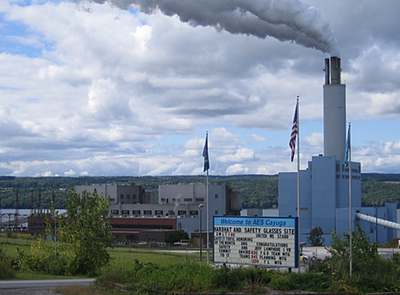- By Dan Veaner
- News
 Print
Print  AES Eastern Energy Limited Partnership (AES Eastern Energy) and 13 affiliated business entities that own or lease six New York energy plants filed Chapter 11 petitions in the United States Bankruptcy Court in Delaware on December 31. For the Lansing plant, AES Cayuga, the outlook isn't as bleak as a Chapter 11 filing makes it sound. Going into the bankruptcy proceedings AES Eastern Energy had an 'agreement in principal' with bondholders that plant officials hope will mean new owners and ongoing operation. That could be good news for plant employees, and good news for Lansing.
AES Eastern Energy Limited Partnership (AES Eastern Energy) and 13 affiliated business entities that own or lease six New York energy plants filed Chapter 11 petitions in the United States Bankruptcy Court in Delaware on December 31. For the Lansing plant, AES Cayuga, the outlook isn't as bleak as a Chapter 11 filing makes it sound. Going into the bankruptcy proceedings AES Eastern Energy had an 'agreement in principal' with bondholders that plant officials hope will mean new owners and ongoing operation. That could be good news for plant employees, and good news for Lansing."We've gone into this Chapter 11 with an agreement in principal with the bond holders," says plant manager Jerry Goodenough. "There is a section on employees. Their intent is to keep as many employees as possible."
AES Eastern Energy's filing lists a billion dollars in debt. The global AES Corporation itself is not included in the bankruptcy filing. The company has reportedly indicated the parent corporation will not make loans or provide cash to help AES Eastern Energy pay its debtors. AES Eastern Energy listed $100 million to $500 million in assets.
Under the terms of the filing the Lansing Plant and the AES Somerset plant in Barker, New York will continue operations under the leadership of the current management teams. Goodenough explains that in bankruptcy filings the plant will go up for auction, with the bondholders' bid being the starting bid. The plant has been struggling over the past couple of years in an economy that has forced it to reduce production to half its 306 megawatts capacity.
 AES Cayuga, formerly known as Milliken Station, is in the northwest corner of Lansing, on Lake Cayuga
AES Cayuga, formerly known as Milliken Station, is in the northwest corner of Lansing, on Lake CayugaThe two key issues impacting the Town of Lansing and Tompkins County are jobs and taxes. AES Cayuga doesn't pay taxes in the same way homeowners do. The plant negotiated a PILOT (Payment In Lieu Of Taxes) agreement with the Tompkins County Industrial Development Agency (IDA) that determines a legally agreed-upon value for the plant. Originally the agreement defined a schedule that increased the plant's value over a period of years, but since that time it has been renegotiated twice, valuing the plant at less and less as the economy and electricity market has been slow to recover. The current value is set at $112.5 million. In two years it will be down to $1 million.
"We're in fairly close communication and feel quite comfortable that AES is keeping us well-informed," says IDA Chairwoman Martha Robertson.
As Lansing's biggest taxpayer, the taxes from the plant most significantly impact the school budget, and to a lesser degree the town, fire district, library, and Tompkins County. Because the school district and library collect taxes in September, the taxing authorities that could be immediately impacted are Tompkins County, The Town of Lansing, and the Lansing Fire District. This month Tompkins County is owed $751,375, the Town $155,306.25, and the Fire District $110,785.43. The plant is also being billed solid waste fees and water bills totaling $129,119.95.
Tompkins County Finance Director David Squires explains that once Chapter 11 is filed obligations incurred after the filing are generally covered. For local municipalities that means that the December 31 filing does not include taxes billed in January. He says this may mean that there might be a delay in the payments as they are routed through Delaware court procedures, but they he expects they will be paid.
In the worst case scenario when a property owner doesn't pay taxes, the county pays the taxing authorities the amount, and then goes about collecting the taxes owed. In the most extreme cases the county may forclose on the property. Because AES has a PILOT agreement it is not on the tax rolls, which means that each taxing authority is on its own where collection is concerned.
AES Cayuga is nowhere near a 'worst case' scenario, and even if it were it is unlikely that it would have an immediate impact on the Town of Lansing or the Lansing Fire District, both of which are in solid financial shape. The Town lowered its tax rate by 15% this year because of a bloated fund balance that the council plans to further reduce over the next three to five years. The Fire District also has healthy reserves.
 AES Cayuga Plant Manager Jerry GoodenoughGoodenough says that motions filed by the plant's representatives were accepted by the bankruptcy judge Wednesday, including a motion to pay the taxes.
AES Cayuga Plant Manager Jerry GoodenoughGoodenough says that motions filed by the plant's representatives were accepted by the bankruptcy judge Wednesday, including a motion to pay the taxes."We have a bill due at the end of January," he says. "Our plan is to pay it, and our plan is for the judge to accept the payment. That doesn't guarantee it, but that's the plan. We are in a PILOT. The 'agreement in principal' with the bondholders includes accepting that contract. We hope that it's not held up in the court."
While the present seems shaky for AES Cayuga, the future looks cautiously promising. The hope is that demand will increase and the economy will finally recover. The plant has continued to operate at some capacity. The management of the plant has been good enough that bondholders are confident in keeping it in place. Going into the bankruptcy proceeding there was a plan to purchase the plant and keep it operating. Town and County officials have repeatedly said that AES has been a 'good citizen' over the years it has been in Lansing, and indications are that has not changed.
Four other affected New York plants are not so lucky. They are no longer operating and will either be retired or sold. If the Lansing plant were to shut down homeowners and other property taxpayers would be forced to make up for the loss in tax revenue. While nothing is assured, AES Cayuga seems to be on a path that will prevent that.
"The best outcome would be to get this deal done with the bondholders, and try to go on a normal business cycle again," says plant manager Jerry Goodenough. "A lot of that is going to be dependent on coal pricing and energy pricing."
v8i1



